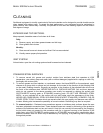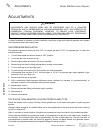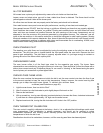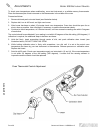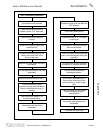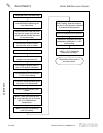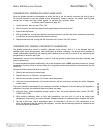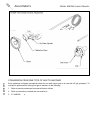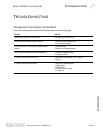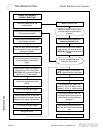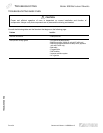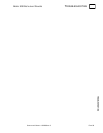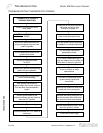
MODEL 300 RESTAURANT RANGES ADJUSTMENTS
THERMOSTATIC GRIDDLE BY-PASS FLAME LEVEL
When the griddle reaches the temperature at which the dial is set, the control cuts down the flow of gas to
the amount required to keep the griddle at that temperature. Always, however, the control must by-pass
enough gas to keep the entire burner lighted. To maintain this minimum flame, the by-pass must be set
carefully and accurately, as follows (see illustration on page 30):
1. Light the burner, then turn dial “FULL ON.”
2. After 5 minutes, turn dial clockwise to point slightly beyond first mark on dial.
3. Remove dial and bezel.
4. With a screwdriver, turn by-pass Adjustor (counterclockwise to increase the flame, clockwise to decrease
it) until there is a minimum flame over the entire burner.
5. Replace bezel and dial, turning the dial clockwise until it locks in the “Off” position.
THERMOSTATIC GRIDDLE THERMOSTAT CALIBRATION
The griddle temperature control is carefully calibrated at the factory—that is, it is so adjusted that dial
settings match actual temperatures. Field recalibration is seldom necessary, and should not be resorted to
unless considerable experience with cooking results definitely proves that the control is not maintaining the
temperatures to which the dial is set.
Recalibration should not be undertaken, however, until the griddle by-pass flame has been adjusted (see
previous subsection).
To check temperatures when recalibrating, use a test instrument with a DISC type thermocouple for surface
temperature checking. Drop a couple of drops of oil on griddle surface plate and place thermocouple disc flat
into the oil.
Proceed as follows (see illustration on page 30):
1. Remove dial and push out metal insert.
2. Replace dial, turn to 350 mark, and light burner.
3. After burner has been on about 15 minutes check temperature.
4. Continue to check temperature, at 5-minute intervals, until two successive readings are within 5 degrees
of each other.
ADJUSTMENTS
The control should be recalibrated if your reading is not within 20 degrees of the dial setting (350 degrees). If
calibration is required, the additional steps to be taken are these:
5. Hold dial firmly, insert screwdriver through center of dial, and push calibration stem inward. DO NOT
TURN THIS STEM.
6. While holding calibration stem in firmly with screwdriver, turn dial until it is set at the actual oven
temperature as shown by your test instrument. Release pressure on calibration stem. Replace dial insert.
7. Set dial at 400 mark. Check temperature again, as instructed in (3) and (4). If the temperature is not
within 20 degrees of the dial setting (400 degrees), it means that the sensing element is inoperative and
the control should be replaced.
OPERATOR’S MANUAL 1182298 REV 3 PAGE 29



